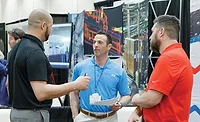Food Automation & Manufacturing Conference report
FA&M Conference Report
Innovating risk assessment and world-class best practices
Not your mother’s risk assessment program
MOM brands, a Minneapolis-based manufacturer of cereals, considers itself an industry leader in food safety, developing programs that raise its confidence in protecting its processing equipment and products, says Scott Kluegel, corporate electrical engineering department manager at MOM Brands. However, a processing-related issue arose that led the company toward new developments in its machine safety and food safety programs.
Materials used in the production of its cereals are converted into dough at one stage in the process. That dough comes into its mill rolls where it is flattened into a sheet and then continues further into the process. “Sometimes the mill rolls become sticky, and the dough collects into baseball- or softball-sized balls. The line operator oftentimes would reach into the mill roll and grab the dough ball,” says Kluegel.
Kluegel says MOM’s previous solutions to these types of issues were more of a subjective process. “We understood from our solutions expert that continuous improvement prompts you to look at your practices, risks and hazards,” and then develop a way to evaluate equipment, identify hazards and estimate the associated risks, he says.
“The expert used a risk assessment methodology based on best practices, his own experience in the field and technical insight to determine the level of protection we needed for the mill rolls and then designed it into our process.
“Determining risk assessment is based on a calculation that identifies the risk related to the identified hazard to determine the risk reduction level,” says Kluegel. That risk level calculation is determined by several factors that are part of a standard risk assessment process.
Those factors include the potential severity of the risk to harm (how badly one could get hurt) and the probability of occurrence of harm, which is based on a determination of the frequency and duration of exposure, probability of harm and probability of avoiding the harm. Each potential issue is assigned a value. For example, the severity of risk could range from level 1, indicating a minor cut or bruise, up to level 4, which could mean a fatality. Values to indicate the frequency and duration of the risk may range from level 1 for less than once a year, through level 5 which indicates a frequency of once an hour.
Probability of occurrence is another factor to be considered. This may be based on the state of the machine, motivation of the operator, stress or awareness of the potential issue. “If the dough ball shows up near the end of shift for the operator, how likely is he or she to shut down the line as opposed to reaching in and grabbing the dough ball?” asks Kluegel. The risk assessment methodology led to the production of a risk reduction decision matrix showing the levels of severity and the different types of probability.
MOM brands assembled a team—consisting of a system safety consultant from Rockwell Automation and MOM Brands company personnel—to adopt a standard risk assessment process that was specific to MOM Brands’ production environment and safety requirements.
The company developed an evolved risk assessment methodology that eliminates the guesswork regarding tasks to address machine safety. It allows safety solutions to be done right the first time with components that are neither under- or over-engineered.
Following the risk assessment, MOM Brands produced three standard documents that look at its machine safety program and the sets they will follow regarding machine safety (LOTO procedures or identifying tasks that are routine, repetitive and integral). A second document lists the types of tasks to be performed on each particular type of equipment. This capability is strictly for maintenance tasks. A third standard document explains how to apply the results of a risk assessment analysis to pieces of equipment. Solutions can range from additional coding added to the machine control software, to new or novel types of machinery, software or components being developed and installed.
Risk assessment methodology helped MOM Brands update safety controls on its processes. Kluegel says the electrical standard for industrial machinery—as recently as 2005—required the safety system for machinery to be separate from and autonomous to the machine control system.
“We implemented a rely-based LED system that was independent of the machine control, but it was expensive to install due to wiring-intensive architectures. Maintenance technicians needed a scorecard to decipher a series of 12 light-based warnings to identify a problem. The relays were cumbersome to install, troubleshoot and maintain,” Kluegel adds.
The company assembled another team to develop an integrated safety system solution. They turned to a PLC system that allowed both the safety system and standard machine controls to operate without conflict on a single platform. With the PLC, MOM Brands was able to better send fault information to a human-machine operator interface, create password-protected levels of security for access to the safety programs and allow remote I/O Ethernet connectivity for reduced wiring.
MOM Brands also conducts better validation testing for machine safety. “We test for the faults before we implement a solution to ensure all parts interact correctly to perform the safety function, and unintended functions do not occur,” says Kluegel. “Does the machinery stop running when I open the door? What should happen to my safety I/O if I lose my network connection? The validation plans include cause and effect so the programmer knows how to develop the logic.”
Looking for a reprint of this article?
From high-res PDFs to custom plaques, order your copy today!





